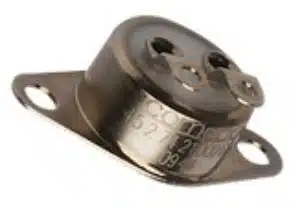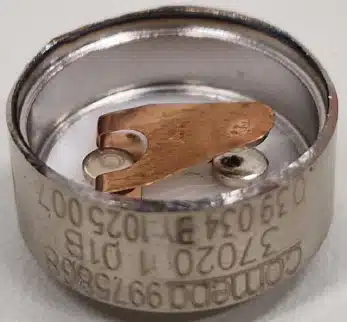This paper Failure Analysis After In Orbit Anomaly On Comepa Bimetallic Thermostat TH47 was presented by Florian Krimmel, ESA/ESTEC, Noordwijk, The Netherlands during the 5th Space Passive Component Days (SPCD), an International Symposium held from October 15th to 18th, 2024, at ESA/ESTEC in Noordwijk, the Netherlands. Published under permission from ESA SPCD organizers.
Introduction
Bimetallic thermostats are integral to spacecraft thermal management systems, ensuring the stable operation of critical subsystems.
The thermostat TH47, employed in the pressure reduction unit of a propulsion subsystem, encountered an in-orbit anomaly after months of nominal operation.
The subsequent failure analysis, conducted at the European Space Agency (ESA), sought to reproduce the anomaly under controlled conditions and identify its root causes to mitigate future risks.
Key Points
- Identification of temperature anomalies in the spacecraft’s propulsion subsystem linked to the TH47 thermostat.
- Reproduction of the anomaly on-ground through controlled thermal cycling.
- Discovery of contact resistance degradation leading to self-heating and functional failure.
- Root cause attributed to silicon-based contaminants causing contact deterioration.
- Implementation of an alternative thermal management strategy to maintain mission safety.
Extended Summary
The anomaly was initially detected through in-flight telemetry, revealing unexpected temperature fluctuations deviating from the thermostat’s nominal operating range of 34°C to 39°C.
The TH47 thermostat, part of a specific manufacturing lot, was suspected as the failure source. Controlled thermal cycles were conducted on samples from the same lot and more recent productions to replicate the anomaly.
The reproduction setup involved precise temperature control using Peltier elements, with meticulous monitoring of body temperature, contact resistance, and switching behavior. It was observed that after several cycles, the thermostat exhibited increased closed contact resistance, leading to self-heating. This phenomenon caused premature switching, with the thermostat turning off before reaching intended temperatures.
Further destructive analysis revealed contamination within the thermostat’s sealed environment. Residual Gas Analysis (RGA) and Scanning Electron Microscopy (SEM) identified silicon-based compounds as contaminants. These compounds degraded under electrical arcing conditions during switching events, forming insulating debris that exacerbated contact resistance issues.
The failure mechanism was linked to silicon-induced contact degradation, where arcing facilitated the breakdown of silicon compounds into non-conductive materials.
This degradation led to erratic thermostat behavior, self-heating, and ultimately, premature contact failure. The issue was isolated to thermostats from a specific manufacturing date, with newer units not exhibiting similar failures.
Conclusion
The comprehensive failure analysis successfully identified the TH47 thermostat as the root cause of the in-orbit anomaly.
The degradation of contact resistance due to silicon contamination resulted in self-heating and functional instability.
By understanding the failure mechanism, ESA implemented a revised thermal management strategy, bypassing the thermostat’s switching function while maintaining subsystem safety.
This case underscores the importance of rigorous component testing and contamination control in spacecraft systems, contributing to improved reliability in future missions.
Read the full paper:































